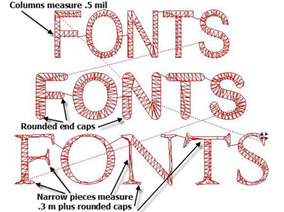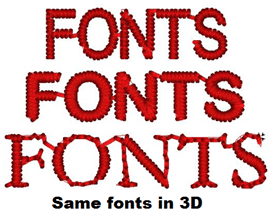
by The Embroidery Coach | | Embroidery Business Marketing
Do you feel like a raise in pay for embroidery employees is the answer to keeping them happy and productive? Maintaining a loyal and satisfied workforce by being creative with your benefits can be an affordable option to increasing wages. You need total team work and co-operation from all of your employees at all times whether they are full-time or part-time employees. There are several ways to gain loyalty and get their best possible effort and co-operation without a raise in pay for embroidery employees.

- Creating flexible working hours for employees that cannot always conform to a strict work schedule of the 7 to 3:30 or 9 to 5 workplace can give you employees that are excellent. For example, moms that have school age children, that need to care for their children around the school schedule. Or a person of retirement age unable to work a full-time schedule or perhaps one that needs time off to care for a loved one. In these cases, the flexibility is very important to the employee and they will typically give their utmost efforts and make good loyal employees.
- Have a group meeting once a week or twice a month and let everyone know how the company is doing. Employees like to feel that they are truly a part of the team and this is one way to gain their trust. When meetings are continuously private, employees become very suspicious and untrusting.
- Treat each employee as if they are the most important person in the workplace. By recognizing the importance of the individual and every job position, you create a friendly, family atmosphere. Each and every job position in the business is dependent on the job previous to and after it. Maintaining this atmosphere in a small workplace is very important. One of the ways to accomplish this is by being present on the floor and periodically checking the work throughout the day yourself. You will gain more respect and employees will try harder to please you. It is very important to convey that you are happy with their performance.
- Express the importance of each and every job position as part of the entire manufacturing process. They all need to be done correctly for the next person to do their part correctly. This is true all the way thru from the Order Taker to the Shipper.
- Wear a smile at all times showing your positive attitude, even when there is a problem present. This is a huge reflection on the entire business. You need to have the position that you are not attacking them for a problem, but trying to solve the problem.
- Include them in proposed changes in the organization, systems or processes of production. By having a meeting to inform them of your plans and asking for their input helps to conquer their fear of change. Production workers can be very insecure and will fight every change that is made whether it is a good or bad, unless they know how it is going to affect them. Feeling that they are part of the change will be much easier to get their co-operation.
A raise in pay should be given on merit and job performance alone and not on longevity. Using this method of increasing salaries gives them the motivation to keep striving for better performance and learning new job skills. A raise in pay based on longevity alone does not motivate anyone to strive for higher performance. Yes, they do need cost of living increases but not an increase based on length of employment.
Surprise them with a treat every now and then. This is another huge way of gaining co-operation and showing appreciation. It does not have to be expensive. A few hours off with pay for when they have done something extraordinary, or even a hot fudge sundae from McDonald‚’s goes a long way in making them happy. Make sure that they are rewarded for their extra efforts. This is something that I did about once per month and no one knew when it was happening. When I would come into the shop with hot fudge sundae‚’s or a pizza, their eyes lit up and they were very happy! This has always been a hugely successful tactic for me to gain co-operation and loyalty!
By utilizing the above benefits, you can build a happy workforce and a more positive working atmosphere without always giving a raise in pay for your embroidery employees.

by The Embroidery Coach | | Embroidery Business Marketing
“9 Tips To Avoid A Financial Crisis In Your Embroidery Business” is an article that I wrote a few years ago and I thought that I would bring back the content of that article because it is so relevant in today’s world!
We have seen so many changes in how we have to do business and how we market our business but when it comes to the financial end of our business, it stays the same. The cost of doing business keeps soaring and we must pay close attention to the day to day operation and do everything that we can to avoid a financial crisis!
In today‚’s world of business, having a superb product, soaring sales and excellent customer service are some of the things that go into making a successful business, but if you do not keep your business financially healthy, all of that hard work will be in vain. Without a sound stable financial position the slightest shock can be enough to send your embroidery business crashing to the ground.
Here are 9 items that can cause your embroidery business to sink and you need to stay on top of each and every one of them in order to avoid a financial crisis and keep your business alive.
Poor Record Keeping
Embroidery Business owners are usually not good record keepers! People who start embroidery businesses are creative and love being in the creative space, bookkeeping is not something that makes them jump out of bed in the morning! They do not get up thinking! “Great, I get to do paperwork today!”
If you are to keep your business going and growing then you have to accept that there are going to be days that you can‚’t avoid it. You must keep records of your sales, your purchases, your production time, and your inventory.
Without these records you will very quickly lose track of where you are. You won‚’t know:
- What you have spent your money on
- You won‚’t know where your cash is going
- You won‚’t know how much you have in inventory
You are effectively working in the dark and this is not conducive to financial stability. So what sort of records are we talking about? Nothing sophisticated. It can be as simple as a book with one page for your income and another for your expenditure. At least once a month total it all up to see how money you have made (I hope!). There‚’s a saying. ‚ÄòThe people who keep records are the people who break records‚’ ‚Äì so true.
Not Keeping Track Of Your Bank Balance
Do you know exactly what your bank balance is today? Why is it important? If you are going to write a check you must know that you have the money on your account. If your check bounces it can damage your reputation and have a negative effect on your credit. This can cause a struggle when dealing with suppliers.
To avoid this make sure you keep a running total in a check book at all time and even get a line of credit so that you can draw on when the cash flow gets low. This can really help in those slow times, but you must repay the line of credit as soon as the cash starts coming in. There really is no excuse for losing track of where you stand.
Poor Cash Flow
When you are working with your customers and purchasing products for them you need to be asking for at least 50% down and then get the remainder of the payment when he or she picks up the order. If you deliver the order, you must collect the remainder before leaving the products.. You cannot afford to work with your money. You need to be working with your customer‚’s money. Carrying Accounts Receivables can kill your business very quickly.
No Cost Controls & Purchasing the Wrong Things
When you are going to make a new purchase, shop around to make sure you are making the right decision. Compare prices and specifications especially on larger purchases. Have your budget set before you start shopping for that new purchase.
Make sure you spend your hard earned cash on the right things. Your business, in order for it to grow, needs cash. Remove the cash and you remove the life blood which keeps your business alive.
You have to be disciplined when planning a new purchase. Always ask yourself the question, ‚ÄúWill this cost add anything to my business? Is it going to help me increase sales?‚Äù Don‚’t act on impulse; go away and think about every large purchase. If it is not going to help increase your sales, then the decision to purchase a new item is not the right one.
Failing To Make Necessary Cuts
Failing to make the necessary cuts to ensure the survival of your business is something you cannot afford to do. If you have an employee that is doing your purchasing for you, keep a check on him or her to make sure that they are not purchasing more than necessary. If your work load decreases, cut some of your labor costs. Do not try to keep them hoping it will pick up, this will be a huge drain on your cash flow. If you notice you have any type of problem do something about it immediately! Don‚’t sit back and hope things will get better; as a general rule, they do not!
If you have product or service that is costing you money, get rid of it. Not acting quickly will only compound the problem.
Depending On a Small Number of Customers
Having a small number of customers is not a problem when everything is going well, but if one or two leave you or fail to pay up on time, then this can cause problems.
If you depend on 3 customers and one of them leaves, you are faced with a 33% reduction in sales. Unless you can replace him immediately you may not be able to cut your overhead costs quick enough to avoid any crisis.
You cannot afford for your business to be held to ransom. Get out as quickly as you can and get new customers.
The same situation can apply to a business that only offers one type of decoration, such as embroidery. A shift in the economy can cause your customers to decide on a more cost effective alternative and all of a sudden, you have no embroidery. You must diversify and offer more cost effective alternatives to your customer when times get tough to keep your customers coming back for more of what you have to offer!
Not Having a Budget
At the beginning of each year sit down and go over your financial reports with a fine tooth comb, Based on your previous year‚’s income and expenditure, create a new budget. Look to see where you can cut back on or even what to cut out altogether if that is necessary to keep costs in line.
Having a good sound budget will help you make the right decision before making any large unnecessary purchases.
Having a good budget will provide you with the discipline to keep track of your expenses. At the end of every month update it by comparing your budget with your actual expenses. Going through this exercise will help you focus on what your business is actually doing.
No Contingency Plan In Place
All business, large or small need to have a contingency plan for all area of the business. A contingency plan is basically a plan which answers the question, “What would we do if this happened …?”
If you are a small embroidery business and basically a one person business you are at even a bigger risk than a larger business that has several employees. If you are ill for a month or two and could not work, who will help you get through that bad time. Do you have any type of insurance that is going to help pay the expenses and give you a salary in order to help you though this time?
Do you have procedure manuals written for all parts of your business so that someone else can step in and take over that part? You need to have a manual for each area of your business that shows how that part of the business works, how each process is done. This includes your office. If something does happen then someone else can follow your instructions and at least keep it going for you. You need to have instructions written down for the entire business flow. Do not depend on your memory to be able to tell someone else what to do. In a time of crises, your brain does not function as normal and this is impossible.
You must do everything that you can to avoid such a crisis! Having good procedural manuals in place is a huge part of that contingency plan.
Not Talking To Your Bank Manager or Loan Officer
As soon as most people see a financial crisis on the horizon, they try and avoid their Bank Manager or their loan office! This is the first person you should speak to. Bank Managers like to be kept up to date with what is happening in your business. They don‚’t like surprises. When they are kept in the dark they can make decisions that can have a major impact on your business. You must go to your bank the moment you suspect there is a problem. Who knows, he may surprise you by offering to do something to help!
Financial problems can usually be avoided by taking a step back from the business and thinking about what can go wrong. Act as an accountant or a trusted adviser and look at your business in that manner. Once you do that, then you can take actions to put preventative measures in place to avoid a financial crisis before it‚’s too late.
I work very closely with many embroiderers and I find that the 9 tips in this article are extremely important to almost all of them. As embroiderers we were not trained to be financial geniuses or business people at all! We are embroiderers that totally enjoy the hands on of performing our day to day operations and creating our designs! The financial end of the business is hard for most of us! Thoroughly read this article, think about your business and what you can do to make the necessary changes in it to avoid any of these financial crisis!

by The Embroidery Coach | | Embroidery Business Marketing
Preparing your business for a disaster is something that most embroiderers do not have on the fore front of their mind as they are starting their embroidery business or even growing their business.
We do not think much about or even have it built into our business plan. If you do not have contingency plans built into your business plan you could lose your shirt, so to speak!
I personally have experienced 2 very devastating disasters in my business that I was not prepared for at all and my insurance agent was very neglectful in helping me to prepare for any type of disaster and it costs me financially and personally a lot of money! I was lucky that I was able to pull out of it, but if I had not had a lot of understanding and great customers, this would not have been the case.
Most Insurance agents do not understand the embroidery business and are in most cases not very informative when you are trying to get the right coverage that you need. They do not ask you the right questions and you do not know the right questions to ask.
One disaster happened to me when the roof of the building that I was renting space in, collapsed from the weight of heavy snow. At the time I had 2 single head machines, a 6 head machine and a 12 head machine. I also had screen printing equipment. It completely destroyed by office, computers, store displays and stock. This was at the beginning of January and I had just finished completing my books for the year and thankfully I had everything from my computer backed up in an external back up system that was not destroyed!
I had insurance to cover my equipment and none of it was damaged to the point where it had to be replaced, but I did not have any insurance to cover the $10,000 that it cost to have all of equipment uncovered from the collapsed room and to have it moved to a new location. Finding a spot large enough that would work for what I needed was not easy. I also had to spend money to renovate the new spot so that it would work for me. I had insurance to cover the loss of customers‚’ goods, but no insurance to cover the loss of time that we were out of business.
I want to share with you information that I received from Pat McKay ofMcKayIns.com about coverage that I could have had if I had asked the right questions. Our embroidery businesses are unique and the coverage that we need to have must be tailor made for our businesses. Here are 7 important questions that we need to ask our insurance agent when we first start talking to them about insurance coverage
- In the event of a claim, how will my software be covered?
- If my machines breakdown will I have coverage for loss of income?
- Are my machines and software covered wherever it is, such as at my place of business or at a show where I am exhibiting?
- Do I have coverage for other people‚’s property that is on my premises?
- Does my policy include liability coverage both on my premises and when I am at my client‚’s office?
- When I‚’m delivering finished products in my van, is the finished product covered by my insurance?
- Do you insure any other embroiderers”
If your agent does not or cannot answer these questions, you need to shop for another insurance agent. Insurance that doesn‚’t fit your business is like not having any insurance at all.
You need to talk to your agent about coverage for all phases of your business.
- Home Based
- On the Road
- On the Internet
- In your Retail Store
I want to share another incident that would have been much easier if I had had the right insurance.
I fell one morning coming out of church and broke my hip! Obviously I was not prepared for this and I did not have my business in the type of condition that anyone could come in and take over for me. I was in the hospital for a week and then at home for 3 months recuperating from this accident. I did not have any insurance to cover me if I was out and I had to struggle through that entire time working from my bed and an ironing board over my bed trying to keep up with as much of the duties that I could during this time.
My business was on the second floor with no elevator, I had no one that could take over my duties and it was extremely hard to try and keep up it was very costly financially. If I had had the insurance to cover me during the time that I was out, it would have been so much easier with a lot less worry. I was not prepared in any way to be out of my business for 3 months. Quality was slipping, customers were not happy and as a result, I lost a lot of business!
Pat McKay has some forms on her insurance website that I want you to go download and fill in. These forms will help you see where you are and what you need to do to get the right coverage. She has a complete “Planning Guide” that will help you be able to go to your insurance agent and make sure that you not only have the right coverage but will also have enough information to ask the right questions. I felt so much more intelligent when I went through this exercise. Download the forms and get them filled in! You will be so glad that you did!
If you would like to talk to Pat directly you can reach her at 330-665-7952 or email her at mckay@mckayins.com. http://www.McKayIns.com. Insurance and the right kind of insurance is so extremely important in protecting your business. Make this part of your business planning. You have worked so hard to build up your business, do not be in the position of a disaster that you are not prepared for and end of losing your shirt! It could happen! Don‚’t let it happen to you! You need to be prepared for any unfortunate disaster in your embroidery business!

by The Embroidery Coach | | Embroidery Business Marketing
How do I make my small lettering look great with a true type font? My customer wants this font that is so thin that it just looks like a run stitch when I try to sew it out. What am I doing wrong? This is a question that I received from one of my students and I thought that I would answer it here in this newsletter.
I am going to use the font and the wording that my customer sent to me.  She could not make it look good and decided to ask me to do it for her. Here is the design and here is my answer to her.
She could not make it look good and decided to ask me to do it for her. Here is the design and here is my answer to her.
As you can see the lettering is far too thin. To keep it simple you need to choose an embroidery font lettering style that is close to the customer‚’s logo, even though it may need to be edited a small amount in order for it to look like the customer’s logo. If you can avoid using a true type font for a situation like this, you are better off. It takes a lot of editing to make it look good, however, it can be done.
Your main issue here is that you have chosen the wrong font to begin with. You must educate your customer and convey to them that you are the professional when it comes to embroidery and you know what will work to make their logo look great and what will not work. What looks good in print does not always work great for embroidery.
There is one major rule that you must remember when you are creating your designs for small lettering. The columns of your lettering must be at least 1 millimeter wide. If you are working with tiny lettering, 4 millimeters high, you must be very careful about what font you choose. This goes for your embroidery fonts as well as true type fonts. This is the minimum measurement after you have added your pullcomp. Your column can be as narrow as .6 millimeters when you bring it in, but after you add your pull comp, it must measure 1 millimeter or it may look like a run stitch when it is sewing out because the column is just not wide enough to create a satin stitch.
To look at this in the right perspective, if you are using a 75/11 needle, the width of your needle as it penetrates into the fabric is .75 millimeters. If you stitch is not 1 millimeter wide you are only going to make a line or worse a hole in your fabric as the needle keeps going up and down in the same spot!
Another rule to remember is not to use a font that has rounded end caps. They do not sew out rounded. They just look messy. If you have chosen this type of font, you must edit it and straighten the ends. Rounded caps only work well if your letters are one inch or larger and you have the skill to create them round. It can definitely be done, I have done this many times, but for the very small lettering, it does not work out the way that you want it to.

 The third font in the pictures below is too narrow and has rounded end caps also. This is definitely not a good font to use, however, this is the font that was sent to me by the embroiderer to use for the Longwood design. Their customer chose this font and insisted on using it so this is the font for the Longwood University design. This is the Garamond font.
The third font in the pictures below is too narrow and has rounded end caps also. This is definitely not a good font to use, however, this is the font that was sent to me by the embroiderer to use for the Longwood design. Their customer chose this font and insisted on using it so this is the font for the Longwood University design. This is the Garamond font.
I want you to see that it can be changed but it does take a lot of editing to make it sew out great!  When you have learned to edit enough to make a font like this sew out great on any type of fabric, you are ready for digitizing.
When you have learned to edit enough to make a font like this sew out great on any type of fabric, you are ready for digitizing.
Try to use basic block fonts instead of fonts with serifs if at all possible. This will eliminate a lot of issues for you and give you a bolder cleaner look.
This is especially true if you are creating your lettering in a circle. This always works better if you are using a regular embroidery font rather than a true type font.
True type fonts always seem to have narrower columns to begin with and are sometimes tough when it comes to creating small lettering with them.
I have created a program that teaches you how to create designs using your embroidery fonts, true type fonts and shapes. It is available to all Gold members of the video training membership website, TheEmbroideryTrainingResourceCenter.com
In this program, I show you how to create 3 different type designs using basic shapes and lettering. I show you how to edit the true type font for the design, Longwood University. This is a great program to teach you how to edit and reshape letters to fit a customer‚’s logo lettering.
This is only one of our programs that is available inside of the membership website that teaches you how to create designs of higher quality for your customers. If you have not a member, click on the link and join today!
TheEmbroideryTrainingResourceCenter.com

by The Embroidery Coach | | Embroidery Business Marketing
The No. One strategy that may be hurting your embroidery business is your mindset! Many times  our thoughts are what hold us back from succeeding at what we want to achieve and may really be hurting our chances of having a successful embroidery business. I wanted to charge higher prices for my embroidery work when I first started my business but then the negative talk started. I had been told so many times that there was no way that I was going to be able to make a living with an embroidery business and then I actually started believing it.
our thoughts are what hold us back from succeeding at what we want to achieve and may really be hurting our chances of having a successful embroidery business. I wanted to charge higher prices for my embroidery work when I first started my business but then the negative talk started. I had been told so many times that there was no way that I was going to be able to make a living with an embroidery business and then I actually started believing it.
We second-guess ourselves and we have doubts when this happens. With all of the negative thoughts and other people‚’s opinions, we soon tell ourselves that we aren‚’t good enough, smart enough, talented enough, or whatever to be able to charge the prices we want or need to for our work. So we end up just settling for what we think we can get and really create a tough struggle for ourselves.
This was a huge struggle for me when I first started my embroidery business and it lasted for almost 15 years! I was convinced that I had to be the lowest priced embroiderer to get the work and stay busy! That mindset almost cost me my entire business!
As a woman, I did not value my time! It was hard for me to ask for the money and price my embroidery as it should have been priced because of all of the negative talk. I collected everyone else‚’s price list and priced my embroidery to match or just a little lower. I almost lost my entire business as a result of it!
I was determined to have the highest quality embroidery of any one that I knew of that was in the embroidery business and I was told many times that I had accomplished that. I was offering this very high quality embroidery at a price that was as low or lower than the embroidery businesses that were offering low quality. How stupid was that!
I did not realize that what I had to offer was a product that I could have priced much higher right from the beginning of my business but my mindset had blocked my ability to see that. It took my accountant practically batting me in the head to get this point across. Either I price my embroidery as I should or close the doors! I was not making any money and I was never going to make any money if I did not change my mindset and my prices. I just knew in my own mind that people would not pay those high prices!
I was so wrong! With my accountants help, I created a whole new pricing structure that was much higher. It was very freighting to me to do this because I just knew that I would lose most of my customers. I did lose some of my customers but they were only the customers that wanted the lowest price.
It was a struggle for me to change that mindset but with his help I was able to do so. I guess you would say, he was my first business coach. When I changed my total mindset and started promoting my quality product and excellent customer service I had plenty of work! Most of my customers were already coming to me for my quality and service and when I raised the prices, they were OK with that.
I found that the secret is not to project your thinking & feelings onto your customers! This mindset held me back for 15 years! Since everyone else was charging low prices, I thought that I had to stay in line with them or charge less to get the customers.
Do not let this happen to you. I would love to be able to convince you and all embroiderers that you need to charge for your expertise. We are not or should not be struggling artists! We are highly skilled professionals and should be paid accordingly and you need to develop the mindset of a professional!
If you are not sure whether or not you have the skill level to be able to charge high prices, get a coach that will help you develop the skill level that you need. Sometimes I just cringe when I see designs that come into to me for a critique. Many embroiderers do not even know that their skill level is not high enough.
I know that I am talking about skill level and charging more for your work, but this is all part of your mindset. If you develop the skills that you need to be a highly skilled embroiderer, then you have earned the right to start charging what you are worth! If you need help in this area, please contact me at joyce@theembroiderycoach.com.
If you have anyone telling you that there is no way you are going to make any money with your embroidery business, close your ears. Learn to block them out. Everyone that teaches about a positive mindset tells you to stay away from negative people. This is not always possible, especially if it is a loved one but you can learn to block them out. That is what I had to do and the negative talk will no longer bother you.
Just stay on your path to creating your highly profitable embroidery business and keep thinking the positive thoughts that are so necessary to have a successful embroidery business.
Without it, you will have a very tough road ahead of you! Stay off that road! Do not travel it at all!






 She could not make it look good and decided to ask me to do it for her. Here is the design and here is my answer to her.
She could not make it look good and decided to ask me to do it for her. Here is the design and here is my answer to her. The third font in the pictures below is too narrow and has rounded end caps also. This is definitely not a good font to use, however, this is the font that was sent to me by the embroiderer to use for the Longwood design. Their customer chose this font and insisted on using it so this is the font for the Longwood University design. This is the Garamond font.
The third font in the pictures below is too narrow and has rounded end caps also. This is definitely not a good font to use, however, this is the font that was sent to me by the embroiderer to use for the Longwood design. Their customer chose this font and insisted on using it so this is the font for the Longwood University design. This is the Garamond font. When you have learned to edit enough to make a font like this sew out great on any type of fabric, you are ready for digitizing.
When you have learned to edit enough to make a font like this sew out great on any type of fabric, you are ready for digitizing.